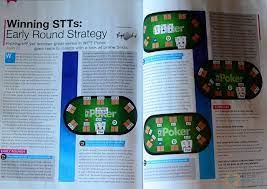The best strategy for the first few blind levels in Sit-N-Go is to play tight, and when an ace or king hits on the flop you should push all in. Normally you should be folding at this level unless you have dealt a large number of starting hands.
When you reach the middle stages, you can play a more loose style of playing depending on your chip stack. If you are low on chips, all your opponents that have not released may be in the same situation as you. If you have played tight up to this point, you can now play aggressively and win the blinds uncontested. When you reach the bubble or the third stage of the game, you should play aggressively in calling all-in bets when you have a chip stack.
In the late stages, you can once again play a more normal style of poker, since the other players at the table have had time to lower their chip stacks and become tighter.
When you reach the final stage of the game, your chip stack will be very low and winning the blinds uncontested is practically the only way to win the tournament. You should not play loosely at this stage, since the low blinds and early raises may cost you too many chips. If you play loosely you may push out players who are low on chips. Your main goal at this stage is to survive to the next level by learning how to play against the particular opponents at your table.
Every level of poker you play, your opponents change. As you have been playing lower level poker, your opponents will have more skills and knowledge about them. The names and styles of poker players also change with each game, but the general playing style remains the same.
The level of threat each player poses to you changes as well. Blinds come in different sizes as well. At the beginning of a level, the blinds are very small. In the middle of a level, the blinds are fairly high. And in the late levels, the blinds are absolutely huge.
Since the blinds raise in a level, you want to make sure your opponents have sufficient stack sizes. If you are up against a player who has a small stack, you will have to take risks to steal the blinds. But if you have a great stack, you can sit back and relax, and let your opponents make mistakes.
There are many players who are great at making mistakes. And there are players who are terrible at NOT making mistakes.
Texas Hold ’em is a game of delicate situational handling. Your ability to do is often directly related to the stack you have at your table.
At low level poker tables, you shouldn’t be going up against multiple opponents without a good hand. If you have a small stack, you should be backing off until you increase your stack or find a table with enough players to warrant the risk.
At high level poker tables, you should be looking for high card opportunities. If you have a good hand, you should be going after the big blind.
Do Not Let Opportunities Blow Away Your Focus
Some of the most important elements of Texas Hold ’em are playing the cards, correctly identifying your opponents, and keeping an eye on your opponents’ actions.
But even when you are paid to play poker, you should still be making an overall assessment of the game, and not constantly focusing on the cards, or on your opponents.
Sometimes the cards just won’t come. And you’ll have to admit it yourself, it can be boring not being as involved with the game as you would like.
After some time, you will start to get a feel for the cards and what beats what, but in the beginning, it’s okay to be somewhat hands-off. You want to let the stone-cold professionals do the talking.
